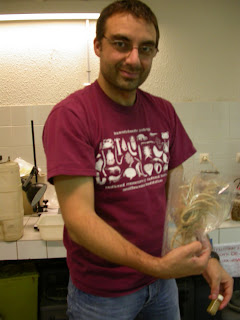
The last month has passed quickly for the Echinoblog's trip to Paris!
It has been a great trip in one of the most beautiful and vivacious cities in the world..
It has been a great trip in one of the most beautiful and vivacious cities in the world..

filled with some of the most delicious food in the world....(which is strangely made with the simplest ingredients). Below.. some Breton cakes (a regional desert made in the Brittany region of France). (click here for a recipe!)

And with barely a day left, I thought I would just end with a brief spotlight on some of the most remarkable of echinoderms studied at the Paris Museum..the crinoids!
Here is a specimen of yet another unearthly animal that doesn't even look real! Yes. This is ALIVE!!! A seldom seen crinoid-a modified feather star from New Caledonia (in the South Pacific) called Gymnocrinus richeri!

Long story short- they are very "living fossil" crinoids..that is a living form that, at least superficially, resemble a species from the fossil record. Sort of like the coelocanth or horseshoe crabs.
here's a pic from the other side... they use those arms to grab prey as it swims by (or so its thought..)
 Here's another specimen more spread out..
Here's another specimen more spread out.. Among the other kinds of better known crinoids are of course, the stalked crinoids (Metacrinus interruptus). aka the "sea lillies"... Stalked crinoids are deep-sea forms that are seldom seen in modern waters (unless you are a deep-sea biologist)..BUT are abundant in Paleozoic fossils..(this is a story for another day.)
Among the other kinds of better known crinoids are of course, the stalked crinoids (Metacrinus interruptus). aka the "sea lillies"... Stalked crinoids are deep-sea forms that are seldom seen in modern waters (unless you are a deep-sea biologist)..BUT are abundant in Paleozoic fossils..(this is a story for another day.) Here's a closeup of the cup that includes the feeding tentacles...
Here's a closeup of the cup that includes the feeding tentacles...
Stalked crinoids typically remain in one place most of the time..but every so often they get moving and become internet superstars!

Finally, the 3rd kind of crinoid-the unstalked or comatulid crinoids...also known as a feather star.. This Antarctic Promachocrinus shown here doing some fancy swimming...
I wanted to thank my hosts to Paris.. here is Dr. Marc Eleaume, one of the scientists-Curator of Echinoderms for the museum..
I wanted to thank my hosts to Paris.. here is Dr. Marc Eleaume, one of the scientists-Curator of Echinoderms for the museum..

and DOCTOR Lenaig Hemery.. who just defended her PhD dissertation next week on Antarctic crinoids and a big-ass phylogeny (aka "family tree") for the ENTIRE living members of the Class Crinoidea.
I wish her the very best and look forward to her future accomplishments! She is shown here with one of "her" animals... the Antarctic feather star Promachocrinus kerguelenensis!
I wish her the very best and look forward to her future accomplishments! She is shown here with one of "her" animals... the Antarctic feather star Promachocrinus kerguelenensis!
 And finally..the ever-busy Dr. Nadia Ameziane-Chief Scientist of the lab who is always a blur of activity! Even taking a picture of her was difficult!
And finally..the ever-busy Dr. Nadia Ameziane-Chief Scientist of the lab who is always a blur of activity! Even taking a picture of her was difficult!
My thanks to all for a great research trip with many new species discovered an many exciting projects underway!!
Are they actually secondarily bilateral?
ReplyDeletehm. that's a good question. It does look like it-but I suspect that its more of a functional aspect of how the arms grow (with smaller, less developed ones on one side). I will have to inquire...
ReplyDeleteRegarding your information about their carnivory, has anybody analyzed their gut content? It would be very interesting to know what kind of bodily modifications required to change a normally filter-feeding group of animal into a flesh-eating one. Almost similar to those deep-sea carnivorous tunicates in my opinion.
ReplyDeleteSo after some consultation and clarification-Gymnocrinus (and all the related holopodids) are pentameral. Its purely an artefact of the picture and the odd shape of the specimen that it appears bilateral. So in answer to your first question-no.
ReplyDeleteFeeding and the biology/idea of structural evolution is poorly known. One note however holopodids are actually regarded as "basal" or having evolved earlier in the history of modern crinoids. So, this feeding mode may be a change from the more commonly encountered suspension feeding-but if so, its an independent and curious offshoot..